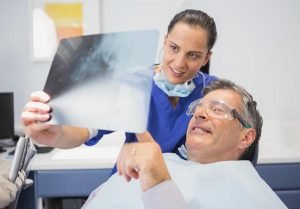The Ins and Outs of Dental X-Rays, And When They are Needed
 At Bondi Dental patients sometimes ask, “Why do I need X-rays?” And it’s a good question. The simple answer is to keep track of your dental health.
At Bondi Dental patients sometimes ask, “Why do I need X-rays?” And it’s a good question. The simple answer is to keep track of your dental health.
X-rays of the mouth and teeth are critical to diagnosing and managing dental conditions. By using X-rays your dentist can detect problems that may not be apparent during a visual examination and often before symptoms present themselves.
The next most common questions have to do with the X-ray procedure and its safety. At Bondi Dental, we have answers!
Why Dentists Take X-rays
To find cavities and tooth decay – Decay can hide in nooks and crannies of the teeth, and also within teeth themselves. Since X-rays reveal hidden decay, they are great tools in determining which teeth have cavities, how much decay is present, and how far it has penetrated.
Reveal bone loss – Severe gum disease, or periodontal disease (Periodontitis), can cause the jaw bone to deteriorate. A visual inspection cannot fully determine to what extent the bone has deteriorated. X-rays allow a dentist to identify where most of the bone loss is happening and recommend appropriate treatment.
Wisdom teeth – Many people have their wisdom teeth removed in their late teens or early twenties to avoid problems in the future. X-rays help your dentist keep an eye on possible problems as they grow.
Orthodontic treatments – While crooked teeth are often identifiable by the naked eye, only about a third of any tooth is actually visible, and it is the whole tooth that needs to be treated. X-rays are used to evaluate the position of the root and which treatments will work most effectively.
Types of X-rays
While technically there are two kinds of X-rays, most X-rays are “intraoral”, meaning the sensor is inside your mouth. Of these X-rays, there are three common kinds:
- Bite-wing X-rays show details of the upper and lower teeth in a particular section of the mouth. A bite-wing X-ray shows a tooth from its crown to the level of the supporting bone.
- Periapical X-rays reveal the entire tooth from its crown to beneath the end of the root to where the tooth is anchored in the jaw.
- Occlusal X-rays show full tooth development and placement. Each X-ray reveals the entire array of teeth in either the upper or lower jaw.
The dental X-ray process
Dental X-rays require no special preparation beyond brushing your teeth prior to your appointment.
The following is the general process for bitewing and periapical X-rays:
- The radiographic technician may place protective garments over the body and neck.
- A radiographic imaging film or digital imaging sensor will be placed in your mouth and you will be asked to bite gently on a stabilizing device.
- The X-ray tubehead will be aligned with the imaging sensor or film near your cheek.
- X-ray exposure is initiated when the technician presses a switch. Normally, the exposure lasts only a fraction of a second.
- The image will be processed.
- Your dentist will analyze your X-rays and make recommendations.
Are X-rays safe?
While nothing is entirely safe, a dental X-ray is not very dangerous. The amount of radiation in full mouth X-ray series is about 1/23 of the radiation you receive from natural sources each year. And with new digital X-ray technology, the radiation exposure is even smaller.
Another way to think about this is to consider the risks that accompany NOT getting X-rays. If you have a dental issue that is “hidden” to the eye, it can threaten your tooth, teeth, and dental and oral health. Dental abscesses, for instance, can be fatal, and X-rays are an invaluable tool in diagnosing how serious they are.
While the level of radiation is already low, care is taken to minimize patient exposure. The X-ray machine focuses tightly on the mouth, and lead aprons and collars are available to protect other parts of the body.
Dental X-rays and kids
Many parents worry about the effect of X-rays on children. Just as in adults, the level of radiation in a dental X-ray is considered safe for a child. And children are particularly susceptible to issues that can be revealed by X-rays. X-rays help dentists:
- Ensure the mouth is large enough to accommodate incoming teeth
- Track the development of wisdom teeth
- Discern if primary teeth are loosening properly to accommodate new permanent teeth
- Identify decay and gum disease before they become serious
If you’re pregnant and have a dental infection, failure to diagnose and treat it could be more dangerous for your baby than the X-ray itself.
The Bondi Dental Advantage
Bondi Dental is located in the Sydney area, at Bondi Beach. We offer high quality dental preventative, restorative, and cosmetic services for all patients in the region. Bondi Dental offers free parking at the rear of the building and FREE dental consultation including a complete dental check-up.
We are open 7 days a week 8am – 8pm!
Call your dentist Bondi Beach on (02) 9365 7187 or visit us at 134 Curlewis St in Bondi Beach.
